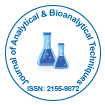Our Group organises 3000+ Global Conferenceseries Events every year across USA, Europe & Asia with support from 1000 more scientific Societies and Publishes 700+ Open Access Journals which contains over 50000 eminent personalities, reputed scientists as editorial board members.
Open Access Journals gaining more Readers and Citations
700 Journals and 15,000,000 Readers Each Journal is getting 25,000+ Readers
Google Scholar citation report
Citations : 6413
Journal of Analytical & Bioanalytical Techniques peer review process verified at publons
Indexed In
- CAS Source Index (CASSI)
- Index Copernicus
- Google Scholar
- Sherpa Romeo
- Academic Journals Database
- Open J Gate
- Genamics JournalSeek
- JournalTOCs
- ResearchBible
- China National Knowledge Infrastructure (CNKI)
- Ulrich's Periodicals Directory
- Electronic Journals Library
- RefSeek
- Directory of Research Journal Indexing (DRJI)
- Hamdard University
- EBSCO A-Z
- OCLC- WorldCat
- Scholarsteer
- SWB online catalog
- Virtual Library of Biology (vifabio)
- Publons
- Euro Pub
- ICMJE
Useful Links
Related Subjects
Share This Page
Non-intrusive blood glucose sensor technology overview
7th International Conference and Exhibition on Analytical & Bioanalytical Techniques
Marc Rippen
Alertgy LLC, USA
Posters & Accepted Abstracts: J Anal Bioanal Tech
Abstract
Current glucose monitoring devices are based on devices originally created in the 1960��?s. They have been made smaller are easier to use and can log data, their measurements basically are the same as the first laboratory sensors. The patent must prick their finger so that they can squeeze a droplet of blood on a strip coated with an enzyme (usually glucose oxidase) that reacts to form hydrogen peroxide from the available glucose and oxygen. The hydrogen peroxide generated is then measured amperometrically with an electrode. The cost, inconvenience and pain incurred in using these systems have led to heavy research to develop non-invasive glucose monitoring techniques. The major current areas of research and the sensor technologies they use will be discussed. The techniques to be covered include interstitial fluid chemical analysis, breath chemical analysis, infrared spectroscopy, optical coherence tomography, temperature modulated localized reflectance, Raman spectroscopy, polarity changes, ultrasound, fluorescence, thermal spectroscopy, ocular spectroscopy and impedance spectroscopy.Biography
Email: marcrippen@aol.com

 Spanish
Spanish  Chinese
Chinese  Russian
Russian  German
German  French
French  Japanese
Japanese  Portuguese
Portuguese  Hindi
Hindi 
